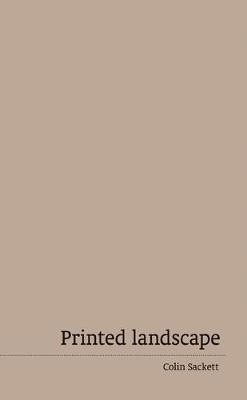 Printed Landscape
Printed Landscape
Colin Sackett
Uniformbooks
Encounters with the uncanny are often in lamp-lit rooms or darkened hollows; abandoned shop fronts, the back room of an antiques centre, a late-night walk through the zoo. They are moments in which we can hear our own heartbeats louder than the too-whit of the owls or the harumph of a motorway. They are the almost-places populated, among whatever other entities are there, by the feeling that something is not exactly real – the anxiety of our own falseness projected into the world.
As a child I was obsessed with these ‘false’ places: Westworld and cardboard cut-out oasis villages; Scooby-doo villains’ abandoned amusement parks; Local Hero and Brigadoon and those Twilight Zone episodes in which everyone but our protagonist is in on something mildly sinister. My Dungeons & Dragons campaigns inevitably ended with the hapless squad discovering that the town they’d been ‘rescuing’ was, in fact, populated by cutthroats and brigands perpetrating a most theatrical crime.
Colin Sackett seems to be obsessed with similar things, with a major distinction. While the uncanny places you and I understand are three-dimensional – whether imagined or encountered, they are places a person can walk through or mannequins one can touch. Sackett’s are on the printed page. Not words describing a place, but the marks on the page itself.
In Printed landscapes – an anthology, of a sort, of certain types of Sackett’s printed work over the past quarter-century – he does a masterful job of confusing print and place in a way that evokes that uncanny feeling of almost. Take, for example, his ‘overprintings’ of London maps: maps of South London and Surrey printed atop one another, rendered unusable by usual map standards. Or his ‘Aggregate’ – the topographical abbreviations associated with an anomalous Croydon wild-land, typed over and over on each other, generating page-depth to a place usually represented by the flatness of its mapping. These maps are a reminder of the futility of cartography as a means to rendering place: what can a few symbols and lines on a page tell us of the impossibility of truly knowing a place? Are we, in fact, setting ourselves up for failure when we arrive somewhere believing our maps?
Many of Sackett’s interests might be thought of as The Beauty of the Limitations of Humans Describing the Land In Print. I’m particularly fond of the instances in which he removes by several decimal points our connection to the land itself: illegible Yellow Pages tear-outs listing ‘Farmers’ by the hundreds; a map of a location by its structures’ phone numbers, with everything else removed; most strangely beautiful of all, a collection of grower’s cards that once came attached to bunches of watercress – the English countryside’s version of ‘For sale: baby shoes, never worn’.
In fact, perhaps one thing the traditional ‘uncanny landscape’ and Sackett’s post-modern, printed ones have in common is the collection. Assemblages of objects, ideas, airs and follies, particularly when encountered without human company, become facsimiles of life: having spent key years of my life working the hidden, employee-only stacks of a public library or digging (several times, literally) in the unfiled and abandoned rooms of record shops, I can speak from experience that the almost-life of these collections reveals things about oneself that we should confront but can be forgiven for not wanting to confront.
Printed landscape is a collection – of previously published pieces of writing and artwork and curation – and it is done in a now-familiar Uniformbooks style: alphabetical, regardless of how out-of-context this renders the pieces. Which succeeds fantastically here, separating similar works while finding previously unnoticed kindred between others. We are left mapless – or, perhaps more accurately, in need of new maps and of ‘making the filaments of a new compass’, as Haniel Long put it.
The heartland of the English uncanny landscape is in the ne’er-world of the Essex-Suffolk border – in Constable Country – where we make real the imaginings on paper of one man’s imperfect notes and ideal memories, and it is unsurprising that such a location makes for the simplest declaration of the author’s intent.
Sackett’s series ‘Illus.’ – fittingly, right in the middle of Printed landscape – includes a reproduction of one of Constable’s 1813 sketchbook, the strangeness of which Sackett reveals in his wonderful, brief, descriptive style. A page of a notebook, a single hour of a single day, its clouds and leaves and minor waves all recorded as ‘a plain pocket aide-mémoire’, reproduced more than 150 years later and distributed widely and indefinitely. A personal token of a moment as one person experienced it, haunting thousands of others, all removed in space and time by increasingly difficult distances, ‘his own hand now passing on unbeknown’.
Printed landscape and plenty more wonders from Colin Sackett’s Uniformbooks imprint are available from his website.